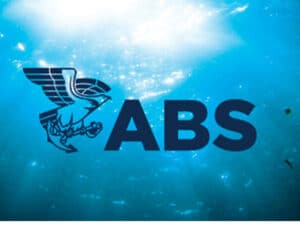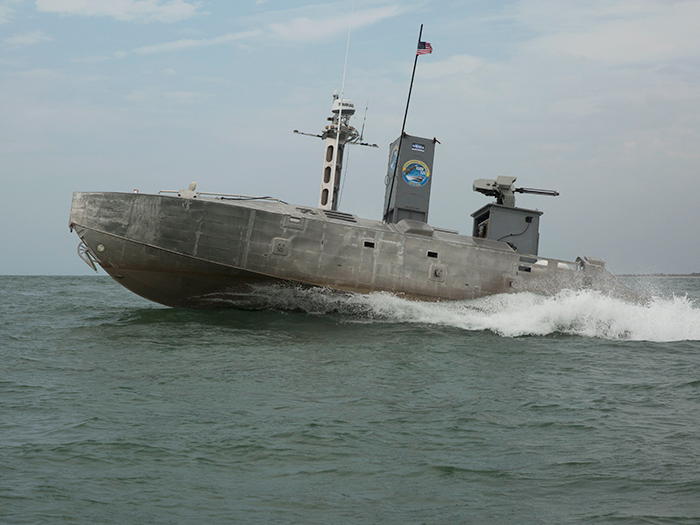
Marine Corps puts weaponized unmanned vessel through its paces
Written by Nick Blenkey
An Expeditionary Warfare Unmanned Surface Vessel autonomously navigates a predetermined course through the water during Advanced Naval Technology Exercise 2019 at Camp Lejeune, N.C. July 12, 2019. ANTX East 2019 is an event designed to test new technology with academic, industry and Navy participants. (Marine Corps photo by Lance Cpl. Nicholas Guevara)
Navy civilian engineers who developed a unique weaponized unmanned surface vehicle (USV) tested by the Marine Corps in July envision that its technological capabilities will revolutionize naval warfare.
The Expeditionary Warfare USV – capable of performing force protection and long-range USV missions during distributed maritime operations, littoral operations in a contested environment, and expeditionary advanced base operations – has been developed for Navy surface warfare and Marine Corps expeditionary warfare missions.
“We believe the USV autonomous sensing, targeting, and engagement systems demonstrate a leap-ahead capability for U.S. Navy and Marine Corps forces,” said John Fiore, Naval Surface Warfare Center Dahlgren Division (NSWCDD) technical director. “This also provides an early look at possible achievements on a larger scale with the future U.S. Navy large and medium USV platforms.”
Marines and distinguished visitors – including Assistant Secretary of the Navy for Research, Development and Acquisition James Geurts and Assistant Commandant of the Marine Corps Gen. Gary Thomas – were present for a July 18 live demonstration as the Expeditionary Warfare USV performed a force protection mission for a high value asset at the July 18 exercise.
“They saw an effective unmanned system for control of inshore and littoral areas, as well as a means to identify and engage remote targets,” said Bob Gripshover, one of the NSWCDD engineers who briefed Geurts and Thomas on the autonomous unmanned system tested during the 2019 Advanced Naval Technology Exercise (ANTX) at Camp Lejeune, N.C.
“There are really two customers for this autonomous surface vehicle,” said Gripshover, who is the technical program manager for the Expeditionary Warfare USV. “We’re trying to prove to the Navy and Marine Corps that it’s possible to use these technologies to make weaponized unmanned surface vehicles as effective as manned ground vehicles.”
“What’s exciting from my perspective is the agility that a venue like this provides us,” said General Thomas. He emphasized that the Marines need new capabilities for their concept of operations to work and that they need them quickly.
“We are also interested in showing the Navy that this type of system is available,” said Gripshover. “As unmanned boats are integrated into the force structure, these weapon automation technologies will be critical to their success. We want the Navy to be aware that putting weapons on unmanned boats involves more than bolting them on the deck. The weapons have to be controlled effectively.”
Gripshover and his team of NSWCDD scientists and engineers worked with their industry partner, Textron Systems, under a Cooperative Research and Development Agreement to integrate expeditionary warfare payloads they developed and integrated onto the company’s Common Unmanned Surface Vehicle.
“There are certain things you can do with these systems that you will never be able to do with manned vehicles,” said Gripshover. “These types of systems opens up new ways of fighting as well as new missions. If fully implemented, these unmanned systems could revolutionize the way we fight.”
Specifically, the Expeditionary Warfare USV could transform how the Navy and Marine Corps provide maritime force protection and maneuver with payloads that include a Longbow Hellfire Missile Launcher and a 50 caliber machine gun on a Sea deFNnder Remote Weapon Station.
“Large numbers of these small, weaponized unmanned vehicles for use in distributed maritime operations and littoral operations in a contested environment will saturate the adversaries’ defenses, and can provide protection for the manned vessels,” said Gripshover. “In the long run, these unmanned systems save lives on both sides. It’s better to have machines fighting machines than to have humans fighting humans.”
At one point during ANTX, the Expeditionary Warfare USV autonomously located potential threats in the open ocean off Onslow Beach and at Mile Hammock Bay in Camp Lejuene while its NSWCDD operators made decisions related to engaging those targets. As the ANTX assessors watched the action, they could see how valuable the USV’s “leap-ahead” capabilities would be in protecting Navy and Marine Corps manned high value assets.
The Expeditionary Warfare USV consists of a 40-foot self-driving boat, a HellFire Longbow missile system, and a .50 gun mounted on a remote weapon station. The boat uses radar and video to navigate, find and track surface contacts while providing tactical behaviors such as automated patrol, intercept, and chase. The gun and missile system use video and infrared systems to automatically identify targets, alert the weapon operator, and provide fire control. The system is operated remotely, either from an ashore site or a ship.
“With these autonomous systems and automated weapons, we are trying to automate enough of the kill chain to allow the human-machine team to react fast enough to deal with multiple incoming threats,” Gripshover explained. “We’re not trying to develop weapons where the machine is in control. We are trying to find the right balance – where the human and machine are both doing what they do best. The machine can search autonomously for potential threats and targets while the human can make the decision on those targets and decide when to engage them. ”
The Navy and Marine Corps are currently assessing the results of the ANTX – including the Expeditionary Warfare USV’s capability of performing expeditionary, littoral, and force protection operations as well as its long-range USV missions in support of expeditionary advanced based -operations. The services will determine if there is potential for further development of any of the technologies demonstrated at the July ‘Fight the Naval Force Forward’ ANTX.
NSWCDD invested approximately $5 million in Naval Innovative Science and Engineering (NISE) Section 219 investments in fiscal year 2018-2019 to enable the command’s scientists and engineers to mature the automated targeting, adaptable missile launcher, and weapons control systems and integrate them into the autonomous Textron System’s CUSV platform creating the Expeditionary Warfare USV.
“This effort represents the gold standard in leveraging NISE 219 funding as a force multiplier to achieving advanced technological capabilities,” said Kathleen Jones, NSWCDD chief technology officer. “We take great pride in the innovation of our scientists and engineers and their efforts to partner with industry and collaborate across warfare centers to bring this capability to fruition.”




